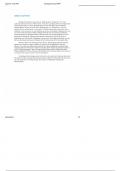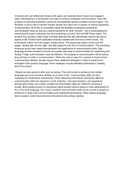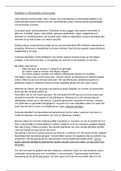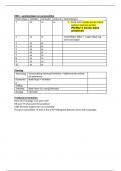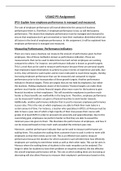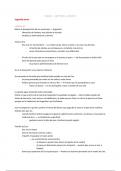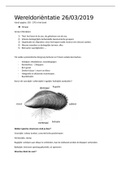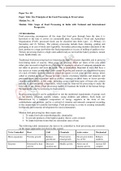A nurse is providing teaching to a client who has a severe form of
stage Il Lyme disease. Which of the following statements made by the
client reflects an understanding of the teaching?
• "I will need to take antibiotics for 1 year." – INCORRECT
o A client who has severe stage I Lyme disease will be
prescribed a 30-day course of antibiotics. The nurse should
emphasize to the client that, like with other types of
infection, the full course of antibiotics should be completed.
• "My partner will need to take an antiviral medication." –
INCORRECT
o Lyme disease is a vector-borne illness that is treated with
antibiotics. Other vector-borne illnesses, such as West Nile
Virus, are treated with antiviral medications. Lyme disease
is not transmitted to others via human contact.
• "My joints ache because I have Lyme disease." – CORRECT
o Lyme disease is a vector-borne illness transmitted by the
deer tick. The disease course occurs in three stages
beginning with joint and muscle pain in stage I. If left
untreated, these symptoms continue throughout stage I
and, by stage Ill, become chronic. Other chronic
complications include memory problems and fatigue
• "I bruise easily because I have Lyme disease. – INCORRECT
o Lyme disease is an infectious disease that affects the body
systemically, involving the neurologic, musculoskeletal, and
cardiac systems. Cardiac manifestations include carditis and
dysrhythmias. However, a client who has stage Il Lyme
disease does not typically experience bruising.
A nurse is caring for a client who is 4 hr postoperative following an
open reduction internal fixation of the right ankle. Which of the
following assessment findings should the nurse report to the provider?
• Extremity cool upon palpation – CORRECT
o The nurse should report indicators of reduced circulation,
such as pallor, cool temperature, or paresthesia of the
client's extremity. These findings can indicate that the client
is at risk for developing acute compartment syndrome.
• Serosanguineous drainage on the dressing – INCORRECT
o Serosanguineous, or blood-tinged, drainage on the dressing
is an expected finding following surgery. Serosanguineous
, drainage is present the first few days following surgery as
the wound heals.
• Capillary refill of 2 seconds – INCORRECT
o A capillary refill of 2 seconds is within the expected
reference range and indicates the client has adequate
arterial blood flow. A delay in capillary refill can indicate an
earl manifestation of acute compartment syndrome.
• Client report of discomfort when moving toes – INCORRECT
o A report of discomfort when moving toes is an expected
finding following surgery. However, a report of increased
pain at the surgical site when moving can indicate an early
manifestation of acute compartment syndrome.
A nurse is assessing a client while suctioning the client's
tracheostomy tube. Which of the following findings should indicate to
the nurse the client is experiencing hypoxia?
• The client starts to cough. – INCORRECT
o The nurse should expect the client to cough during
suctioning of a tracheostomy due to bronchial stimulation.
• The client's heart rate increases. – CORRECT
o Hypoxia related to suctioning can cause the client's heart
rate to increase. If this occurs, the nurse should discontinue
the suctioning and manually oxygenate the client with
100% oxygen. The nurse should instruct the client to take
three or four deep breaths prior to suctioning to reduce the
risk for hypoxia.
• The client is diaphoretic. – INCORRECT
o Diaphoresis is not associated with suction-induced hypoxia.
However, long-term hypoxia can lead to diaphoresis.
• The client's blood pressure decreases. – INCORRECT
o A clients blood pressure can increase initially with hypoxia.
If this occurs, the nurse should stop suctioning and
manually oxygenate the client. Long-term hypoxia can lead
to a decrease in blood pressure and shock
A nurse is caring for a client who is 8 hr postoperative following a total
hip arthroplasty. The client is unable to void on the bedpan. Which of
the following actions should the nurse take first?
• Document the client's intake and output. – INCORRECT
o The nurse should document the client's intake and output to
ensure adequate fluid balance. However, there is another
action that the nurse should take first.
, • Scan the bladder with a portable ultrasound. – CORRECT
o The first action the nurse should take using the nursing
process is to assess the client. Scanning the bladder with a
portable ultrasound device will determine the amount of
urine in the bladder.
• Pour warm water over the client's perineum. – INCORRECT
o Pouring warm water over the client's perineum is a method
for stimulating micturition. However, there is another action
that the nurse should take first.
• Perform a straight catheterization. – INCORRECT
o Performing a straight catheterization might prove necessary.
However, there is another action that the nurse should take
first.
A nurse is providing discharge instructions to a client who has active
tuberculosis (TB). Which of the following information should the nurse
include in the instructions?
• Sputum specimens are necessary every 2 to 4 weeks until
there are three negative cultures. – CORRECT
o After three negative sputum cultures, the client is no longer
considered infectious.
• The contagious period generally lasts for 6 to 8 weeks after the
initiation of medication therapy. – INCORRECT
o The client's infection is usually no longer contagious after
taking TB medications for 2 to 3 weeks.
• Family members should follow airborne precautions at home. –
INCORRECT
o Family members do not need to follow airborne precautions
because they have already been exposed to TB.
• A follow-up tuberculosis skin test is necessary in 2 months. -
INCORRECT
o A follow-up evaluation of the client's TB should be
performed using a chest x-ray because the TB skin test is
no longer considered accurate after a person has tested
positive
A nurse is caring for a client who has increased intracranial pressure
(ICP) and is receiving mannitol via continuous IV infusion. Which of the
following findings should the nurse report to the provider as an adverse
effect of this medication?
• Decreased heart rate – INCORRECT
, o Tachycardia is an adverse effect of mannitol that the nurse
should report
• Crackles heard on auscultation – CORRECT
o Mannitol is an osmotic diuretic that prevents the
reabsorption of water in the kidneys, thus increasing urinary
output. With the exception of the brain, mannitol can leave
the vascular system at the capillary site, which can result in
edema. The nurse should identify crackles as a
manifestation of pulmonary edema and notify the provider.
Other manifestations include dyspnea and decreased
oxygen saturation.
• Increased urinary output – INCORRECT
o Mannitol is an osmotic diuretic and increased diuresis is a
therapeutic effect.
• Decreased deep tendon reflexes – INCORRECT
o A decrease in the deep tendon reflex response is an
indication of hypercalcemia or hypermagnesemia. An
adverse effect of mannitol is electrolyte loss
A nurse is providing discharge teaching to a client who is postoperative
following a modified radical mastectomy. Which of the following
instructions should the nurse include?
• Flex the affected arm when ambulating. – INCORRECT
o The nurse should instruct the client to stand upright and
avoid flexing the affected arm when ambulating to reduce
the risk for elbow contracture.
• Numbness can occur along the inside of the affected arm. –
CORRECT
o The nurse should instruct the client that numbness can
occur near the incision and along the inside of the affected
arm due to nerve injury.
• Begin active range-of-motion exercises 1 day after surgery. –
INCORRECT
o The nurse should instruct the client to begin active range-of-
motion exercises 1 week after surgery to increase mobility
without causing stress on the incision.
• Dress in clothing that fits snugly. – INCORRECT
o The nurse should instruct the client to dress in loose-fitting
clothing to reduce the risk of stress on the incision.

